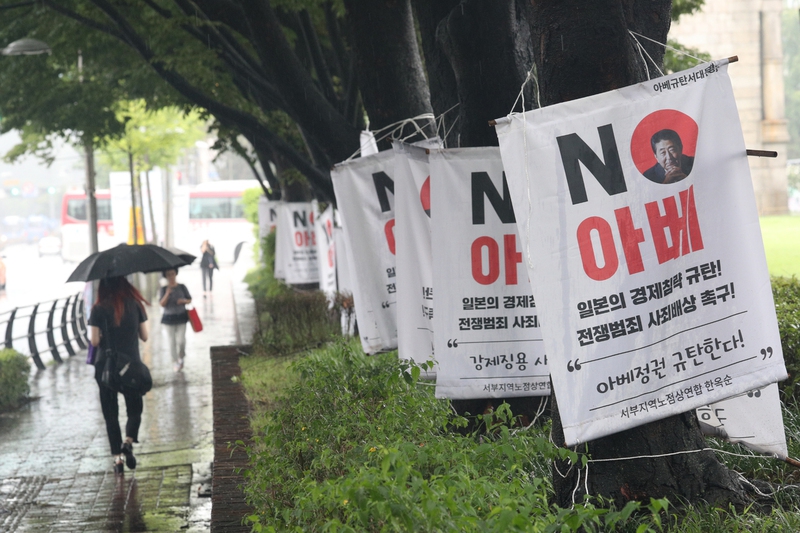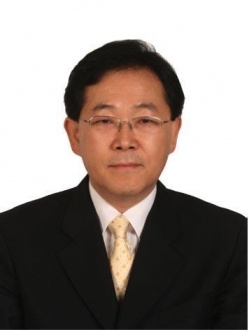 |
|
Anti-abe demonstrators gather in front of Seodaemun Prison to protest the Shinzo Abe administration’s trade measures on Aug. 12. (Kim Bong-gyu, staff photographer)
|
An in-depth look at those directing policy in Tokyo
Japan’s move to implement export controls on South Korea and exclude it from Japan’s white list was targeted at the heart of the Korean economy. The Japanese government has been preparing specific countermeasures to the South Korean Supreme Court ruling on forced labor and the expected sale (seizure) of the assets of Japanese companies since January last year. With the Prime Minister’s Official Residence at the basecamp, the Japanese Ministry of Trade, Economy and Industry (METI) has been crafting a plan for economic retaliation so elaborate that related departments exchanged contact several times per day. It appears that the Prime Minister’s Official Residence has ordered “three major principles” that are capable of sending shockwaves through the Korean economy while not influencing people to people relations between Korea and Japan and maintaining the General Security of Military Information Agreement (GSOMIA). The economic retaliation is full of contradictions and gaps both in terms of its justification and reality. It is difficult to understand whether the measures are economic retaliation or a strengthening of export controls and why, if they are motivated by security reasons, Japan did not first seek to end GSOMIA. It is also unclear whether it is correct for Japan to launch the baseless accusation that “hydrogen fluoride exported to (South) Korea was leaked to North Korea” while pushing ahead with an unconditional Japan-North Korea summit meeting at the same time. It is difficult to claim that sufficient agreement had been reached between Prime Minister Shinzo Abe and his associates, the Ministry of Foreign Affairs (MOFA) and the METI, Japanese corporations, the LDP, and right-wing media. As bureaucratic entities, the two ministries are deeply dissatisfied with the current situation where the issue of forced labor has been recklessly intertwined with economic retaliation. The export regulations on Korean companies, which are connected to global production and supply chains, have almost no effect in practice, and the basis for the measures flies in the face of common sense. Attack on S. Korea orchestrated by Abe and close associates In that case, who is behind this attack on Korea, and how did it come about? This situation was orchestrated by Abe, his close associates and right-wing officials from the LDP. These figures are statesmen and key bureaucrats who are blindly loyal to the prime minister, and many of them are connected to the METI. It is believed that the MOFA has been effectively kept out of the picture. Yachi Shotaro, national security advisor to the prime minister, largely regarded as the brain behind Abe’s diplomacy, and Minister of Foreign Affairs Kono Taro, have barely played a role in policy decisions related to the current situation. Yachi’s influence over Abe has been greatly reduced since the comfort women agreement reached between South Korea and Japan in December 2015 led to the dissolution of the Reconciliation and Healing Foundation near the end of last year. Some parts of Abe’s obsession with the comfort women issue and the Statue of Peace are difficult to understand under normal circumstances. Instead of the “sincere apology and reflection as the prime minister” prescribed by paragraph 1 of the comfort women agreement, Abe has made the issue a point of diplomatic contention on two further occasions and obsessed over the phrase “final, irreversible solution,” which has not been raised as a problem in the international community. He believes that the essence of the comfort women problem is not healing the pain of the victims with Japan apologizing and reflecting on the past, but simply a diplomatic card that Korea holds against Japan. Accordingly, he views it as more important for Japan to not apologize and cover up facts than learn from the past and prevent history from repeating itself. The government has revisited the Kono Statement, which admitted that the country forcibly brought people to Japan, and ordered the MOFA to interfere with the erection of Statues of Peace in the US and other countries. Abe’s associates have claimed that the sex slavery claims are fabricated or that the women involved did so voluntarily. Kawamura Takashi, the Mayor of Nagoya, recently removed a Statue of Peace from an exhibit hall at the Aichi Triennale 2019. The historical distortions and mistrust of Korea by Abe and his associates reached fever pitch after the South Korean Supreme Court’s ruling on compensation for forced labor in October last year. Abe criticized the decision by the Korean judiciary as a challenge to the international order established through the 1951 Treaty of San Francisco and a “outright violation of international law,” referring to the 1965 claims agreement. Abe has been quick to criticize the South Korean government, without giving any consideration to the harm suffered by individuals under the illegal 35-year colonial occupation of Korea, the principle of separation of powers, the fact that individual rights to claims are still relevant, and the lengthy lawsuits filed by victims as they continue to grow older. The claim that Korea cannot be trusted for security reasons, and therefore had to be struck off the export white list, was first put forward in January this year by Aoyama Shigeharu, a member of the House of Councillors, in a meeting between the LDP and MOFA after the targeting radar dispute. Aoyama is a right-wing politician and long-time friend of Abe, who took part in an advertisement opposing US House of Representatives Resolution 121 on the “comfort women” issue. He is also a security and trade expert and a member of the National Diet Committee on Economy and Industry. Around the same time, Akaike Masaaki, another member of the House of Councillors, advocated economic sanctions against Korea beginning with specific, immediately implementable measures. Another proposal was also put forward at this time to cut off the supply of strategic goods such as high-purity hydrogen fluoride, a cleaning agent used in the manufacture of semiconductors. The Moon Jae-in administration has continued to seek communication and dialogue with the US and Japan while pushing ahead with the Korean Peninsula peace process. However, Japan demands a complete and comprehensive solution to issues such as Japanese nationals kidnapped by North Korea and the North’s nuclear weapons and missiles, including mid-range missiles. Japan does not believe North Korea’s promise to denuclearize, and believes that the country will not abandon its nuclear ambitions. The historic dispute between South Korea and Japan has caused the gap between the two countries on North Korea policy to widen. In the end, the Abe administration was able to manipulate South Korea’s image during the radar lock-on dispute in January to brand it as a “country that cannot be trusted on security matters.” The talk of “shared strategic benefits between South Korea and Japan” that Abe had normally referred to in his State of the Union address completely disappeared in this year’s address. The Abe administration’s prolonged term has created the by-product of a foreign policy that has no strategy or consistency. Those that orchestrated the economic retaliation are mostly former bureaucrats or politicians who are loyal followers of Abe and have been involved in politics with him for a long time. They have also become friendly with one another over a long period of time through Regional Revitalization, Nippon Kaigi, the Shinto Association of Spiritual Leadership, and a group that visits the Yasukuni Shrine. Recently, these officials have been monopolizing key policy decisions on Northeast Asian diplomacy while shutting out Japan’s Ministry of Foreign Affairs. Abe’s associates have been responsible for the offer made to Russia of returning the “Northern Territories” (four of the Kuril Islands), a point of contention between Japan and Russia, in exchange for US$30 billion in economic cooperation, as well as seeking a cooperative relationship with China as a hedging strategy in response to the US-China trade war, and the establishment of a dedicated North Korea department within its foreign ministry two years ago. ”New mainstream” of Abe administration needs to monitored Some of the most notable figures in this group are Imai Takaya, executive secretary to the prime minister, who hails from the Ministry of Trade and Industry, the predecessor to METI, Hasegawa Eiichi, special advisor to the prime minister, who is also a former bureaucrat from the Ministry of Trade and Industry. Eiichi is also Imai’s senior from the University of Tokyo Faculty of Law, and served as minister of the Small and Medium Enterprises Bureau. There is also METI Minister Hiroshige Seko, who is a loyal supporter of Abe within the LDP and an expert in trade and industry, and Hagiuda Koichi, executive secretary, who has received criticism for advocating replacing the Speaker of the House of Representatives in order to amend the Constitution. These officials have been hovering around Abe, building up established relationships of trust through LDP meetings and serving as the prime minister’s secretaries. As METI bureaucrats or members of the National Diet Committee on Economy and Industry, they are all well-versed in trade and industrial economics, and another commonality is that they are in their 50s or 60s, making them comparatively young in the world of Japanese politics and the “new mainstream” within the Prime Minister’s Official Residence and the LDP. In the cabinet reshuffle that is expected to take place in September, Motegi Toshimitsu, who has already served in the cabinet during Abe’s second term in office as the METI minister, has been unofficially given the nod as the next minister of foreign affairs. These bureaucrats are very hawkish on issues such as the territory dispute with China over the Senkaku Islands (Diaoyudao Islands) and the return of the Northern Territories, and have no qualms about visiting Yasukuni Shrine and distorting Japan’s history of sexual enslavement and the Nanjing massacre. They have been responsible for determining the core direction of Abe’s foreign policy, while Kono Taro and Yachi Shotaro, who are close to the foreign ministry line that stresses the importance of strategic decisions, have been left out of policy decision-making. These right-wing politicians have very different views from the traditional diplomatic lines that viewed South Korea-Japan relations as important, and it is also worth noting that they view diplomatic issues through the lens of trade. They favor strategic national benefit over solutions to historical disputes, a biased perception of trade over alliances, and bilateral relations over multilateral relations, and believe in the importance of exercising technological power in Japan’s interest. Rather than mediating between the interests of the Prime Minister’s Official Residence and bureaucratic agencies, they collude behind closed doors.
 |
|
Yang Ki-ho, professor of Japanese Studies at Sungkonghoe University
|







